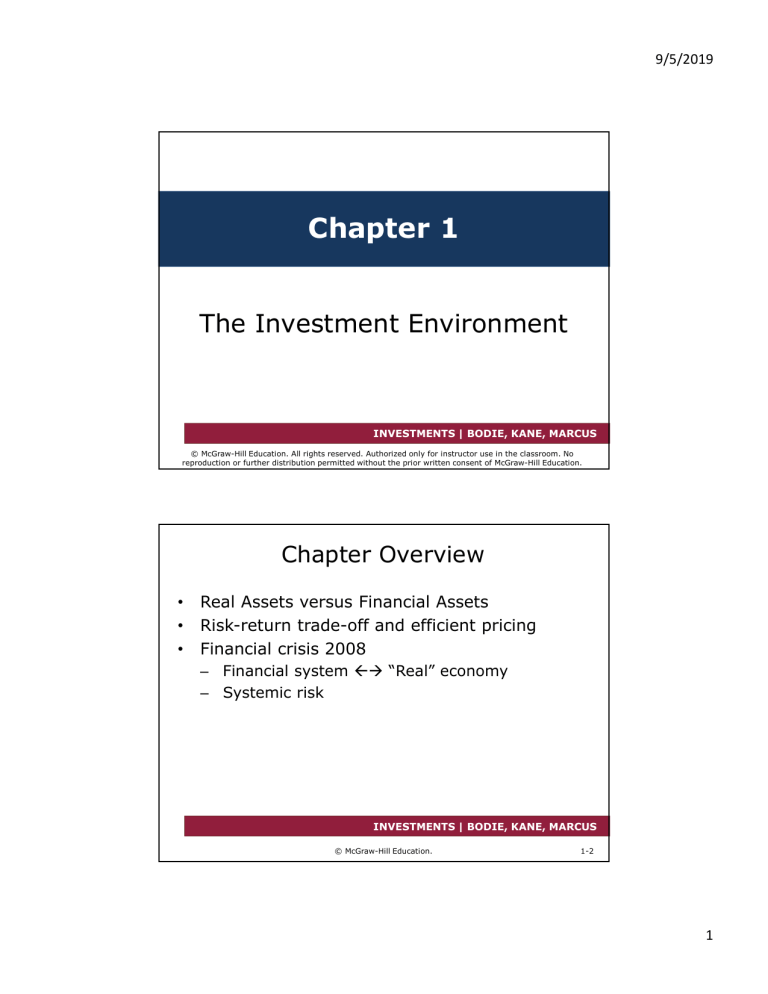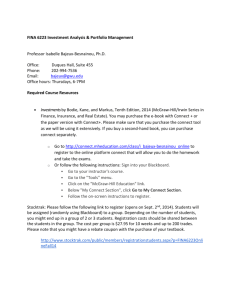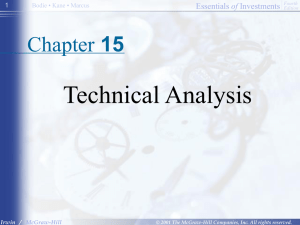
9/5/2019 Chapter 1 The Investment Environment INVESTMENTS | BODIE, KANE, MARCUS © McGraw-Hill Education. All rights reserved. Authorized only for instructor use in the classroom. No reproduction or further distribution permitted without the prior written consent of McGraw-Hill Education. Chapter Overview • • • Real Assets versus Financial Assets Risk-return trade-off and efficient pricing Financial crisis 2008 – Financial system “Real” economy – Systemic risk INVESTMENTS | BODIE, KANE, MARCUS © McGraw-Hill Education. 1-2 1 9/5/2019 Investments • • AN INVESTMENT is the current commitment of money or other resources in the expectation of reaping future benefits Save now, hope to consume more later INVESTMENTS | BODIE, KANE, MARCUS © McGraw-Hill Education. 1-3 Real Assets Versus Financial Assets Real Assets • • Financial Assets Have Productive Capacity Examples: Land, buildings, machines, intellectual property • Claims on real assets • Do not contribute directly to productive capacity • Examples: Stocks, bonds INVESTMENTS | BODIE, KANE, MARCUS © McGraw-Hill Education. 1-4 2 9/5/2019 Financial Assets • Financial Assets: Claims on Real Assets – Fixed-Income Securities: Promises a fixed stream of income or a stream of income determined by a specified formula; debt – Equity: Represents ownership share in a corporation; common Stock – Derivatives: Provide payoffs that are determined by the prices of other assets INVESTMENTS | BODIE, KANE, MARCUS © McGraw-Hill Education. 1-5 Other Types of Investment • • Investment in currency Commodity futures – Corporations invest in the commodity futures to hedge the risk INVESTMENTS | BODIE, KANE, MARCUS © McGraw-Hill Education. 1-6 3 9/5/2019 Financial Markets and the Economy (1 of 4) • • • • Capital / resource allocation through markets The Informational Role Consumption Timing Allocation of Risk INVESTMENTS | BODIE, KANE, MARCUS © McGraw-Hill Education. 1-7 Financial Markets and the Economy (2 of 4) • Separation of Ownership and Management – Agency Problems: Managers’ interests vs. owners’ interests INVESTMENTS | BODIE, KANE, MARCUS © McGraw-Hill Education. 1-8 4 9/5/2019 Financial Markets and the Economy (3 of 4) • Mechanisms to mitigate Agency Problems: – Tie managers' income to the success of the firm – Monitoring from the board of directors – Monitoring by large investors and security analysts – Activist investor – Takeover threat INVESTMENTS | BODIE, KANE, MARCUS © McGraw-Hill Education. 1-9 Financial Markets and the Economy (4 of 4) • Corporate Governance and Corporate Ethics – Accounting Scandals Enron, WorldCom – Auditors: Watchdogs Arthur Andersen (consulting and auditing for Enron) – Analyst Scandals – Sarbanes-Oxley Act Corporate governance rules (2002) INVESTMENTS | BODIE, KANE, MARCUS © McGraw-Hill Education. 1-10 5 9/5/2019 The Investment Process (1 of 2) • Portfolio: Collection of investment assets – Create, update/rebalance • Asset allocation – Choice among broad asset classes • Security selection – Choice of securities within each asset class INVESTMENTS | BODIE, KANE, MARCUS © McGraw-Hill Education. 1-11 The Investment Process (2 of 2) • “Top-down” approach – Asset allocation followed by security analysis • “Bottom-up” approach – Investment based solely on the priceattractiveness INVESTMENTS | BODIE, KANE, MARCUS © McGraw-Hill Education. 1-12 6 9/5/2019 Markets Are Competitive (1 of 3) • • Risk-Return Trade-Off Higher-risk assets are priced to offer higher expected returns than lower-risk assets Risk and expected return are positively correlated INVESTMENTS | BODIE, KANE, MARCUS © McGraw-Hill Education. 1-13 Markets Are Competitive (2 of 3) • • Efficient Markets Efficient markets: prices quickly adjust to all relevant information There should be neither underpriced nor overpriced securities INVESTMENTS | BODIE, KANE, MARCUS © McGraw-Hill Education. 1-14 7 9/5/2019 Markets Are Competitive (3 of 3) • Passive Management – Holding a highly diversified portfolio – No attempt to find undervalued securities – No attempt to time the market • Active Management – Finding mispriced securities – Timing the market INVESTMENTS | BODIE, KANE, MARCUS © McGraw-Hill Education. 1-15 The Players (1 of 2) Role of Government? Can be either borrowers or lenders INVESTMENTS | BODIE, KANE, MARCUS © McGraw-Hill Education. 1-16 8 9/5/2019 The Players (2 of 2) Financial Intermediaries: Pool and invest funds, connecting the suppliers of capital with the demanders of capital • – – – – Investment Companies Banks Insurance companies Credit unions INVESTMENTS | BODIE, KANE, MARCUS © McGraw-Hill Education. 1-17 Universal Bank Activities Investment Banking Commercial Banking • Underwrite new securities issues • Sell newly issued securities to public in the primary market • Take deposits and make loans INVESTMENTS | BODIE, KANE, MARCUS © McGraw-Hill Education. 1-18 9 9/5/2019 Financial Crisis of 2008 (1 of 3) • Antecedents of the Crisis: – “The Great Moderation” – Historic boom in housing market • “The Big Short”, Michael Lewis INVESTMENTS | BODIE, KANE, MARCUS © McGraw-Hill Education. 1-19 Financial Crisis of 2008 (2 of 3) “The Great Moderation” Figure 1.2 Cumulative returns on the S&P 500 index INVESTMENTS | BODIE, KANE, MARCUS © McGraw-Hill Education. 1-20 10 9/5/2019 Financial Crisis of 2008 (3 of 3) Historic boom in housing market Figure 1.3 The Case-Shriller Index of U.S. housing prices INVESTMENTS | BODIE, KANE, MARCUS © McGraw-Hill Education. 1-21 Figure 1.1 Short-Term LIBOR and Treasury-Bill Rates and the TED Spread INVESTMENTS | BODIE, KANE, MARCUS © McGraw-Hill Education. 1-22 11 9/5/2019 Changes in Housing Finance (1 of 2) Old Way New Way • Local thrift institution made mortgage loans to homeowners • Securitization: Fannie Mae and Freddie Mac bought mortgage loans and bundled them into large pools • Thrift’s possessed a portfolio of long-term mortgage loans • Mortgage-backed securities are tradable claims against the underlying mortgage pool • Thrift’s main liability: Deposits • “Originate to hold” • “Originate to distribute” INVESTMENTS | BODIE, KANE, MARCUS © McGraw-Hill Education. 1-23 Changes in Housing Finance (2 of 2) • • • • • Securitization: Inclusion of nonconforming “subprime” loans Low/No-documentation loans Rising loan-to-value ratio Adjustable-Rate Mortgages INVESTMENTS | BODIE, KANE, MARCUS © McGraw-Hill Education. 1-24 12 9/5/2019 Figure 1.4 Cash Flows in a Mortgage Pass-Through Security INVESTMENTS | BODIE, KANE, MARCUS © McGraw-Hill Education. 1-25 Mortgage Derivatives • Collateralized debt obligations (CDOs) – Mortgage pool divided into tranches to concentrate default risk: Senior tranches: Junior tranches: – Ratings significantly underestimated risk INVESTMENTS | BODIE, KANE, MARCUS © McGraw-Hill Education. 1-26 13 9/5/2019 Why Was Credit Risk Underestimated? • • • Default probabilities were misestimated Geographic diversification did not reduce risk sufficiently Agency problems with rating agencies INVESTMENTS | BODIE, KANE, MARCUS © McGraw-Hill Education. 1-27 Credit Default Swap (CDS) • A CDS is an insurance contract against borrower default – Investors bought sub-prime loans and CDSs – Some big swap issuers did not have enough capital to back their CDSs – This lack of capital resulted in the failure of CDO insurance INVESTMENTS | BODIE, KANE, MARCUS © McGraw-Hill Education. 1-28 14 9/5/2019 Rise of Systemic Risk (1 of 3) • Systemic Risk: – One default triggers Further Defaults Further Defaults Further Defaults – Waves of selling downward spiral as asset prices drop – Potential contagion INVESTMENTS | BODIE, KANE, MARCUS © McGraw-Hill Education. 1-29 Rise of Systemic Risk (2 of 3) • Banks mismatched maturity/liquidity of their assets and liabilities: – Liabilities were short and liquid – Assets were long and illiquid – Constant need to refinance • Banks: highly leveraged no margin of safety INVESTMENTS | BODIE, KANE, MARCUS © McGraw-Hill Education. 1-30 15 9/5/2019 Rise of Systemic Risk (3 of 3) • • Investors relied too much on credit enhancement through structured products CDS traded mostly over-the-counter – No posted margin requirements – Little transparency • Opaque linkages between instruments and institutions INVESTMENTS | BODIE, KANE, MARCUS © McGraw-Hill Education. 1-31 The Shoe Drops (1 of 2) • • • 2004: Interest rates began rising 2006: Home prices peaked 2007: Housing defaults and losses on mortgage-backed securities surged INVESTMENTS | BODIE, KANE, MARCUS © McGraw-Hill Education. 1-32 16 9/5/2019 The Shoe Drops (2 of 2) • 2008: Troubled firms include Bear Stearns, Fannie Mae, Freddie Mac, Merrill Lynch, Lehman Brothers, and AIG – Money market breaks down – Credit markets freeze up – Federal bailout to stabilize financial system INVESTMENTS | BODIE, KANE, MARCUS © McGraw-Hill Education. 1-33 The Dodd-Frank Reform Act Mechanisms to Mitigate Systemic Risk • Mechanisms to mitigate systemic risk – Stricter rules for bank capital, liquidity, and risk management practices – Increased transparency, especially in derivatives markets – Office of Credit Ratings within the SEC to oversee the credit rating agencies INVESTMENTS | BODIE, KANE, MARCUS © McGraw-Hill Education. 1-34 17 9/5/2019 End of Presentation INVESTMENTS | BODIE, KANE, MARCUS © McGraw-Hill Education. All rights reserved. Authorized only for instructor use in the classroom. No reproduction or further distribution permitted without the prior written consent of McGraw-Hill Education. 1-35 18




